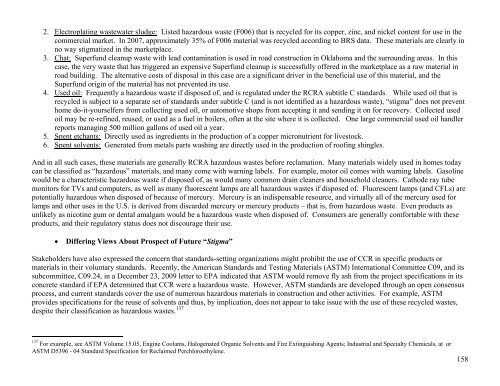Analysis - The Institute for Southern Studies
Analysis - The Institute for Southern Studies
Analysis - The Institute for Southern Studies
Create successful ePaper yourself
Turn your PDF publications into a flip-book with our unique Google optimized e-Paper software.
2. Electroplating wastewater sludge: Listed hazardous waste (F006) that is recycled <strong>for</strong> its copper, zinc, and nickel content <strong>for</strong> use in the<br />
commercial market. In 2007, approximately 35% of F006 material was recycled according to BRS data. <strong>The</strong>se materials are clearly in<br />
no way stigmatized in the marketplace.<br />
3. Chat: Superfund cleanup waste with lead contamination is used in road construction in Oklahoma and the surrounding areas. In this<br />
case, the very waste that has triggered an expensive Superfund cleanup is successfully offered in the marketplace as a raw material in<br />
road building. <strong>The</strong> alternative costs of disposal in this case are a significant driver in the beneficial use of this material, and the<br />
Superfund origin of the material has not prevented its use.<br />
4. Used oil: Frequently a hazardous waste if disposed of, and is regulated under the RCRA subtitle C standards. While used oil that is<br />
recycled is subject to a separate set of standards under subtitle C (and is not identified as a hazardous waste), “stigma” does not prevent<br />
home do-it-yourselfers from collecting used oil, or automotive shops from accepting it and sending it on <strong>for</strong> recovery. Collected used<br />
oil may be re-refined, reused, or used as a fuel in boilers, often at the site where it is collected. One large commercial used oil handler<br />
reports managing 500 million gallons of used oil a year.<br />
5. Spent etchants: Directly used as ingredients in the production of a copper micronutrient <strong>for</strong> livestock.<br />
6. Spent solvents: Generated from metals parts washing are directly used in the production of roofing shingles.<br />
And in all such cases, these materials are generally RCRA hazardous wastes be<strong>for</strong>e reclamation. Many materials widely used in homes today<br />
can be classified as “hazardous” materials, and many come with warning labels. For example, motor oil comes with warning labels. Gasoline<br />
would be a characteristic hazardous waste if disposed of, as would many common drain cleaners and household cleaners. Cathode ray tube<br />
monitors <strong>for</strong> TVs and computers, as well as many fluorescent lamps are all hazardous wastes if disposed of. Fluorescent lamps (and CFLs) are<br />
potentially hazardous when disposed of because of mercury. Mercury is an indispensable resource, and virtually all of the mercury used <strong>for</strong><br />
lamps and other uses in the U.S. is derived from discarded mercury or mercury products – that is, from hazardous waste. Even products as<br />
unlikely as nicotine gum or dental amalgam would be a hazardous waste when disposed of. Consumers are generally com<strong>for</strong>table with these<br />
products, and their regulatory status does not discourage their use.<br />
<br />
Differing Views About Prospect of Future “Stigma”<br />
Stakeholders have also expressed the concern that standards-setting organizations might prohibit the use of CCR in specific products or<br />
materials in their voluntary standards. Recently, the American Standards and Testing Materials (ASTM) International Committee C09, and its<br />
subcommittee, C09.24, in a December 23, 2009 letter to EPA indicated that ASTM would remove fly ash from the project specifications in its<br />
concrete standard if EPA determined that CCR were a hazardous waste. However, ASTM standards are developed through an open consensus<br />
process, and current standards cover the use of numerous hazardous materials in construction and other activities. For example, ASTM<br />
provides specifications <strong>for</strong> the reuse of solvents and thus, by implication, does not appear to take issue with the use of these recycled wastes,<br />
despite their classification as hazardous wastes. 137<br />
137 For example, see ASTM Volume 15.05, Engine Coolants, Halogenated Organic Solvents and Fire Extinguishing Agents; Industrial and Specialty Chemicals, at or<br />
ASTM D5396 - 04 Standard Specification <strong>for</strong> Reclaimed Perchloroethylene.<br />
158




